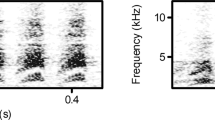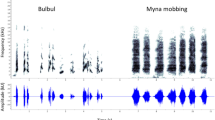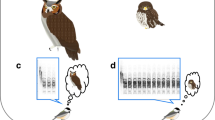Abstract
Many bird species vary their alarm calls according to the level of risk they face and this information can be used by receivers to respond to the mobbing event. Recent studies have also found that the number of callers can play an important role in the decision of subsequent individuals to join a mobbing event. We conducted a playback experiment to assess if differences in calling rate and number of callers elicit different behavioural responses in the house wren (Troglodytes aedon chilensis). We broadcast the alarm call of either one or two individuals, at different calling rates along the breeding season. We found that house wrens responded more frequently during playback of alarm calls at higher rates than during playback of calls at lower rates. However, focal individuals moved closer to the speaker when calls were played back at lower rates. There were no differences in the response of house wrens when we broadcast the calls of one or two individuals. These results suggest that call rates are an important element in the communication of danger in the house wren, rather than caller number.
Significance statement
Mobbing is an anti-predator strategy observed in many species, and often involves the use of calls that can communicate to conspecifics and heterospecifics about the threat of the predator. Understanding the factors and cues that receivers use to respond is an important element in understanding communication between individuals. We studied the role of call rate and number of callers in the behavioural response to mobbing calls of individuals in the house wren during the breeding season. Using a playback experiment, we show that individuals respond more often to calls played at a high rate, regardless of the number of callers. House wrens' call rates vary according to the level of perceived risk, so our results show that receivers use this information to respond to mobbing calls.



Similar content being viewed by others
Data availability
The data is included as a supplementary information file.
References
Baker MC, Becker AM (2002) Mobbing calls of black-capped chickadees: effects of urgency on call production. Wilson Bull 114:510–516. https://doi.org/10.1676/0043-5643(2002)114[0510:MCOBCC]2.0.CO;2
Blumstein DT, Verneyre L, Daniel JC (2004) Reliability and the adaptive utility of discrimination among alarm callers. Proc R Soc B 271:1851–1857. https://doi.org/10.1098/rspb.2004.2808
Brooks ME, Kristensen K, van Benthem KJ, Magnusson A, Berg CW, Nielsen A, Skaug HJ, Maechler M, Bolker B (2017) glmmTMB balances speed and flexibility among packages for zero-inflated generalized linear mixed modelling. R J 9:378–400. https://doi.org/10.3929/ethz-b-000240890
Carlson NV, Griesser M (2021) Mobbing in animals: A thorough review and proposed future directions. Adv Stud Behav 54:1–41. https://doi.org/10.1016/bs.asb.2022.01.003
Carlson NV, Healy SD, Templeton CN (2017) A comparative study of how British tits encode predator threat in their mobbing calls. Anim Behav 125:77–92. https://doi.org/10.1016/j.anbehav.2017.01.011
Carro ME, Fernández GJ (2021) Alarm calls of house wrens (Troglodytes aedon bonariae) elicit responses of conspecific and heterospecific species. Behaviour 158:829–847. https://doi.org/10.1163/1568539X-bja10097
Coomes JR, McIvor GE, Thornton A (2019) Evidence for individual discrimination and numerical assessment in collective antipredator behaviour in wild jackdaws (Corvus monedula). Biol Lett 15:20190380. https://doi.org/10.1098/rsbl.2019.0380
Corral MG, Carro ME, Fernández GJ (2012) Alarm calls of nesting Southern House Wrens (Troglodytes musculus). Ornitol Neotrop 23:251–260
Couchoux C, Clermont J, Garant D, Réale D (2018) Signaler and receiver boldness influence response to alarm calls in eastern chipmunks. Behav Ecol 29:212–220. https://doi.org/10.1093/beheco/arx152
Curio E (1978) The adaptive significance of avian mobbing: I. Teleonomic hypotheses and predictions. Z Tierpsychol 48:175–183. https://doi.org/10.1111/j.1439-0310.1978.tb00254.x
Curio E, Klump G, Regelmann K (1983) An anti-predator response in the great tit (Parus major): is it tuned to predator risk? Oecologia 60:83–88. https://doi.org/10.1007/BF00379324
Duré Ruiz NM, Fasanella M, Fernández GJ (2018) Breeding southern house wrens exhibit a threat-sensitive response when exposed to different predator models. J Ethol 36:43–53. https://doi.org/10.1007/s10164-017-0528-6
Dutour M, Cordonnier M (2023) The number of Great Tit mobbers influences the mobbing response of heterospecific birds. Ibis, (published online). https://doi.org/10.1111/ibi.13224
Dutour M, Fernández GJ, Randler C (2022) How great tits respond to urgency-based information in allopatric Southern house wren mobbing calls. Ethology 128:676–683. https://doi.org/10.1111/eth.13329
Dutour M, Kalb N, Salis A, Randler C (2021) Number of callers may affect the response to conspecific mobbing calls in great tits (Parus major). Behav Ecol Sociobiol 75:29. https://doi.org/10.1007/s00265-021-02969-7
Dutour M, Lena JP, Lengagne T (2016) Mobbing behaviour varies according to predator dangerousness and occurrence. Anim Behav 119:119–124. https://doi.org/10.1016/j.anbehav.2016.06.024
Ellis JMS (2008) Which call parameters signal threat to conspecifics in white-throated magpie-jay mobbing calls? Ethology 114:154–163. https://doi.org/10.1111/j.1439-0310.2007.01439.x
Evans CS, Evans L, Marler P (1993a) On the meaning of alarm calls: functional reference in an avian vocal system. Anim Behav 46:23–38. https://doi.org/10.1006/anbe.1993.1158
Evans CS, Macedonia JM, Marler P (1993b) Effects of apparent size and speed on the response of chickens, Gallus gallus, to computer-generated simulations of aerial predators. Anim Behav 46:1–11. https://doi.org/10.1006/anbe.1993.1156
Fallow PM, Magrath RD (2010) Eavesdropping on other species: Mutual interspecific understanding of urgency information in avian alarm calls. Anim Behav 79:411–417. https://doi.org/10.1016/j.anbehav.2009.11.018
Fasanella M, Fernández GJ (2009) Alarm calls of the Southern House Wren Troglodytes musculus: variation with nesting stage and predator model. J Ornithol 150:853–863. https://doi.org/10.1007/s10336-009-0406-2
Fernández GJ, Carro ME (2022) Alarm calls of southern house wrens, Troglodytes aedon bonariae, convey information about the level of risk. Ethology 128:293–302. https://doi.org/10.1111/eth.13255
Fernández GJ, Corral MG, Carro ME (2012) Variation in the alarm calls of Southern House Wrens (Troglodytes musculus). Emu-Austral Ornithology 112:71–75. https://doi.org/10.1071/MU11033
Fernández GJ, Corral MG, Llambías PE (2015) Sexual differences in risk-taking behaviour of the Southern house wren during the nestling rearing stage. Acta Ethol 18:11–18. https://doi.org/10.1007/s10211-013-0177-x
Flasskamp A (1994) The adaptive significance of avian mobbing V. An experimental test of the ‘move on’ hypothesis. J Ethol 96:322–333. https://doi.org/10.1111/j.1439-0310.1994.tb01020.x
Fox J, Weisberg S (2019) An R companion to applied regression, 3rd edn. Sage Publications, Thousand Oaks, CA
Francis AM, Hailman JP, Woolfenden GE (1989) Mobbing by Florida scrub jays: behaviour, sexual asymmetry, role of helpers and ontogeny. Anim Behav 38:795–816. https://doi.org/10.1016/S0003-3472(89)80112-5
Gallego-Abenza M, Blum CR, Bugnyar T (2021) Who is crying wolf? Seasonal effect on antipredator response to age-specific alarm calls in common ravens, Corvus corax. Learn Behav 49:159–167. https://doi.org/10.3758/s13420-020-00455-0
Griesser M (2009) Mobbing calls signal predator category in a kin group-living bird species. Proc R Soc B 276:2887–2892. https://doi.org/10.1098/rspb.2009.0551
Hamilton WD (1971) Geometry for the selfish herd. J Theo Biol 31:295–311. https://doi.org/10.1016/0022-5193(71)90189-5
Hare JF (1998) Juvenile Richardson's ground squirrels, Spermophilus richardsonii, discriminate among individual alarm callers. Anim Behav 55:451–460. https://doi.org/10.1006/anbe.1997.0613
Hartig F (2020) DHARMa: residual diagnostics for hierarchical (multi-level/mixed) regression models. R package version 0.3.3.0, http://florianhartig.github.io/DHARMa/
Hurd CR (1996) Interspecific attraction to the mobbing calls of black-capped chickadees (Parus atricapillus). Behav Ecol Sociobiol 38:287–292. https://doi.org/10.1007/s002650050244
Igic B, Ratnayake CP, RadfordAN MRD (2019) Eavesdropping magpies respond to the number of heterospecifics giving alarm calls but not the number of species calling. Anim Behav 148:133–143. https://doi.org/10.1016/j.anbehav.2018.12.012
Kalb N, Anger F, Randler C (2019) Subtle variations in mobbing calls are predator-specific in great tits (Parus major). Sci Rep 9:6572. https://doi.org/10.1038/s41598-019-43087-9
Kalb N, Randler C (2019) Behavioral responses to conspecific mobbing calls are predator-specific in great tits (Parus major). Ecol Evol 9:9207–9213. https://doi.org/10.5061/dryad.1v31m0c
Klump GM, Shalter MD (1984) Acoustic behaviour of birds and mammals in the predator context; I. Factors affecting the structure of alarm signals. II. The functional significance and evolution of alarm signals. Z Tierpsychol 66:189–226. https://doi.org/10.1111/j.1439-0310.1984.tb01365.x
Krams I, Bērziņš A, Krama T (2009) Group effect in nest defence behaviour of breeding pied flycatchers, Ficedula hypoleuca. Anim Behav 77:513–517. https://doi.org/10.1016/j.anbehav.2008.11.007
Leavesley AJ, Magrath RD (2005) Communicating about danger: urgency alarm calling in a bird. Anim Behav 70:365–373. https://doi.org/10.1016/j.anbehav.2004.10.017
Lenth R (2020) emmeans: Estimated Marginal Means, aka Least-Squares Means. R package version 1.5.1, https://CRAN.R-project.org/package=emmeans
Manser MB, Seyfarth RM, Cheney DL (2002) Suricate alarm calls signal predator class and urgency. Trends Cogn Sci 6:55–57. https://doi.org/10.1016/S1364-6613(00)01840-4
McLachlan JR, Magrath RD (2020) Speedy revelations: how alarm calls can convey rapid, reliable information about urgent danger. Proc R Soc B 287:20192772. https://doi.org/10.1098/rspb.2019.2772
Nieder A (2020) The adaptive value of numerical competence. Trends Ecol Evol 35:605–617. https://doi.org/10.1016/j.tree.2020.02.009
Owings DH (2010) Tonic communication in the antipredator behavior of ground squirrels. Adv Stud Behav 41:119–149. https://doi.org/10.1016/S0065-3454(10)41004-9
R Core Team (2020) R: A language and environment for statistical computing. R Foundation for Statistical Computing, Vienna, Austria https://www.R-project.org/
Rajala M, Rätti O, Suhonen J (2003) Age differences in the response of willow tits (Parus montanus) to conspecific alarm calls. Ethology 109:501–509. https://doi.org/10.1046/j.1439-0310.2003.00890.x
Randler C, Förschler MI (2011) Heterospecifics do not respond to subtle differences in chaffinch mobbing calls: message is encoded in number of elements. Anim Behav 82:725–730. https://doi.org/10.1016/j.anbehav.2011.07.002
Randler C, Vollmer C (2013) Asymmetries in commitment in an avian communication network. Sci Nat 100:199–203. https://doi.org/10.1007/s00114-013-1009-6
Salis A, Léna JP, Lengagne T (2022) Which acoustic parameters modify the great tit’s response to conspecific combinatorial mobbing calls? Behav Ecol Sociobiol 76:46. https://doi.org/10.1007/s00265-022-03157-x
Schleidt WM (1973) Tonic communication: continual effects of discrete signs in animal communication systems. J Theor Biol 42:359–386. https://doi.org/10.1016/0022-5193(73)90095-7
Shah SS, Greig EI, MacLean SA, Bonter DN (2015) Risk-based alarm calling in a non-passerine bird. Anim Behav 106:129–136. https://doi.org/10.1016/j.anbehav.2015.05.011
Sloan JL, Hare JF (2004) Monotony and the information content of Richardson's ground squirrel (Spermophilus richardsonii) repeated calls: Tonic communication or signal certainty? Ethology 110:147–156. https://doi.org/10.1111/j.1439-0310.2003.00955.x
Sloan JL, Hare JF (2006) Adult Richardson's ground squirrels (Spermophilus richardsonii) ignore rate changes in juvenile alarm calls: Age-differential response urgency perception? Ethology 112:896–902. https://doi.org/10.1111/j.1439-0310.2006.01235.x
Sloan JL, Hare JF (2008) The more the scarier: Adult Richardson’s ground squirrels (Spermophilus richardsonii) assess response urgency via the number of alarm signallers. Ethology 114:436–443. https://doi.org/10.1111/j.1439-0310.2008.01479.x
Sloan JL, Wilson DR, Hare JF (2005) Functional morphology of Richardson's ground squirrel, Spermophilu srichardsonii, alarm calls: The meaning of chirps, whistles and chucks. Anim Behav 70:937–944. https://doi.org/10.1016/j.anbehav.2005.01.013
Sommer C, Todt D, Ostreiher R, Mundry R (2012) Urgency-related alarm calling in Arabian babblers, Turdoides squamiceps: Predator distance matters in the use of alarm call types. Behaviour 149:755–773. https://doi.org/10.1163/1568539X-00003003
Sternalski A, Bretagnolle V (2010) Experimental evidence of specialised phenotypic roles in a mobbing raptor. Behav Ecol Sociobiol 64:1351–1361. https://doi.org/10.1007/s00265-010-0950-z
Sumpter DJ, Pratt SC (2009) Quorum responses and consensus decision making. Phil Trans R Soc B 364:743–753. https://doi.org/10.1098/rstb.2008.0204
Szabo B, Valencia-Aguilar A, Damas-Moreira I, Ringler E (2022) Wild cognition–linking form and function of cognitive abilities within a natural context. Curr Opin Behav Sci 44:101115. https://doi.org/10.1016/j.cobeha.2022.101115
Audacity Team (2017) Audacity (Version 2.2.1), https://www.audacityteam.org/
Templeton CN, Greene E (2007) Nuthatches eavesdrop on variations in heterospecific chickadee mobbing alarm calls. P Natl Acad Sci USA 104:5479–5482. https://doi.org/10.1073/pnas.0605183104
Templeton CN, Greene E, Davis K (2005) Allometry of alarm calls: black-capped chickadees encode information about predator size. Science 308:1934–1937. https://doi.org/10.1126/science.1108841
Therneau T (2015) Mixed effects Cox models, https://cran.r-project.org/web/packages/coxme/vignettes/coxme.pdf
Warkentin KJ, KeeleyAT HJF (2001) Repetitive calls of juvenile Richardson's ground squirrels (Spermophilus richardsonii) communicate response urgency. Can J Zool 79:569–573. https://doi.org/10.1139/z01-017
Welbergen JA, Davies NB (2008) Reed warblers discriminate cuckoos from sparrowhawks with graded alarm signals that attract mates and neighbours. Anim Behav 76:811–822. https://doi.org/10.1016/j.anbehav.2008.03.020
Wheatcroft D (2015) Repetition rate of calls used in multiple contexts communicates presence of predators to nestlings and adult birds. Anim Behav 103:35–44. https://doi.org/10.1016/j.anbehav.2015.02.009
Wheatcroft D, Price TD (2018) Collective action promoted by key individuals. Am Nat 192:401–414. https://doi.org/10.1086/698874
Woods RD (2016) Collective responses to acoustic threat information in jackdaws. PhD Thesis, University of Exeter
Woods RD, Kings M, McIvor GE, Thornton A (2018) Caller characteristics influence recruitment to collective anti-predator events in jackdaws. Sci Rep 8:7343. https://doi.org/10.1038/s41598-018-25793-y
Acknowledgments
We thank Mrs M. Ester Neumeyer and Mr Ramón Rementería for allowing us to carry out this study on their property. We thank Mandy Ridley and two anonymous reviewers for their helpful comments that helped to improve the paper.
Author information
Authors and Affiliations
Contributions
All authors listed have made a substantial, direct, and intellectual contribution to the work and approved it for publication. GJF: conceptualization, data curation, formal analysis, investigation, methodology, visualization, project administration, supervision, writing-review and editing; MD: conceptualization, visualization, project administration, methodology, writing-review and editing; MEC: conceptualization, data curation, formal analysis, methodology.
Corresponding author
Ethics declarations
Ethical statement
This study did not involve the capture or handling of birds and complied in accordance with current local and national laws and regulations in Argentina. Although our playback experiments changed the immediate behaviour of the targeted birds, we do not feel that these experiments were stressful. Indeed, all tested birds returned to normal activity relatively quickly after the playbacks. In addition, we have no evidence that our experiment affected the long-term behaviour of individuals or their reproductive success. This study and the protocols we used were approved by the Dirección Provincial de Áreas Naturales Protegidas y Recursos Faunísticos from the Neuquén province, Argentina (Disp 025/22).
Conflict of interest
The authors declare that the research was conducted in the absence of any commercial or financial relationships that could be considered as a potential conflict of interest.
Additional information
Communicated by P. A. Bednekoff
Publisher’s note
Springer Nature remains neutral with regard to jurisdictional claims in published maps and institutional affiliations.
Rights and permissions
Springer Nature or its licensor (e.g. a society or other partner) holds exclusive rights to this article under a publishing agreement with the author(s) or other rightsholder(s); author self-archiving of the accepted manuscript version of this article is solely governed by the terms of such publishing agreement and applicable law.
About this article
Cite this article
Fernández, G.J., Dutour, M. & Carro, M.E. Information transfer during mobbing: call rate is more important than the number of callers in a southern temperate passerine. Behav Ecol Sociobiol 77, 78 (2023). https://doi.org/10.1007/s00265-023-03357-z
Received:
Revised:
Accepted:
Published:
DOI: https://doi.org/10.1007/s00265-023-03357-z




